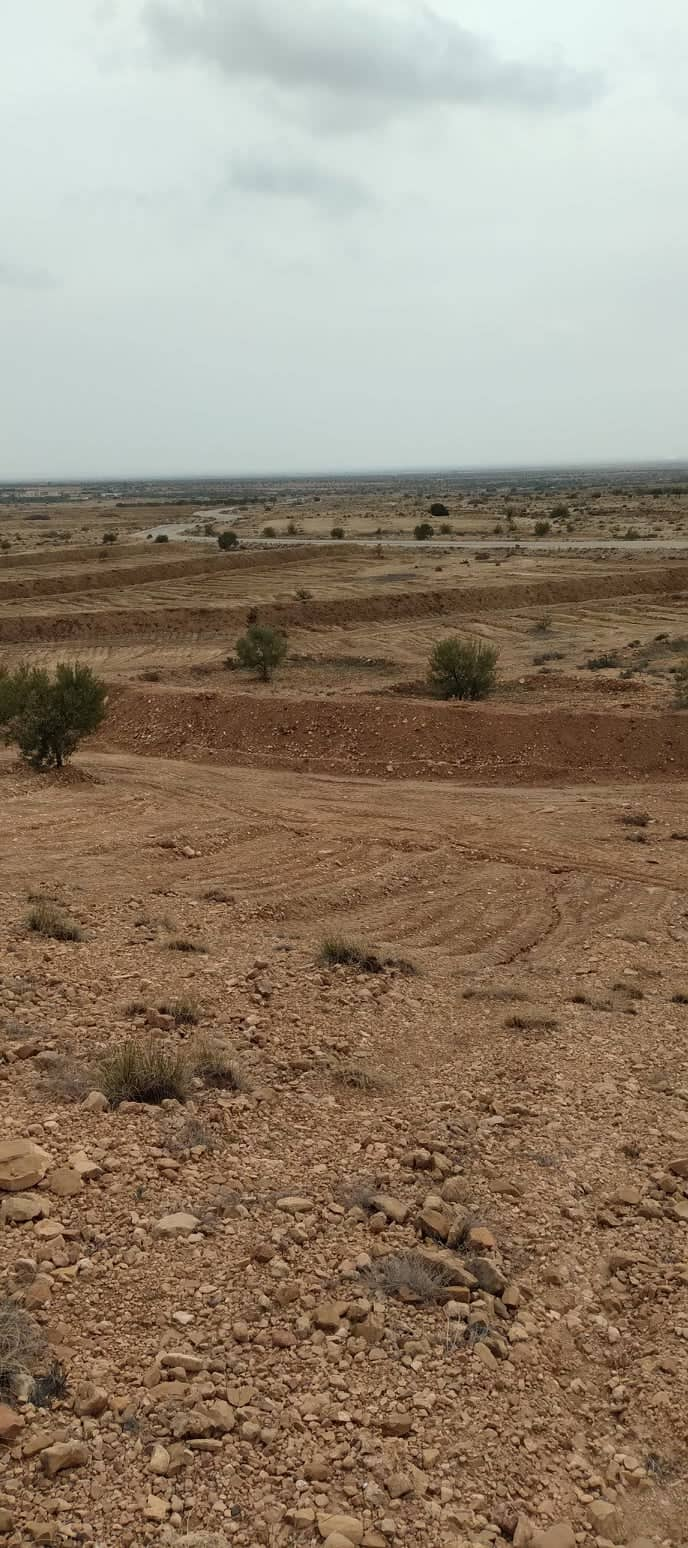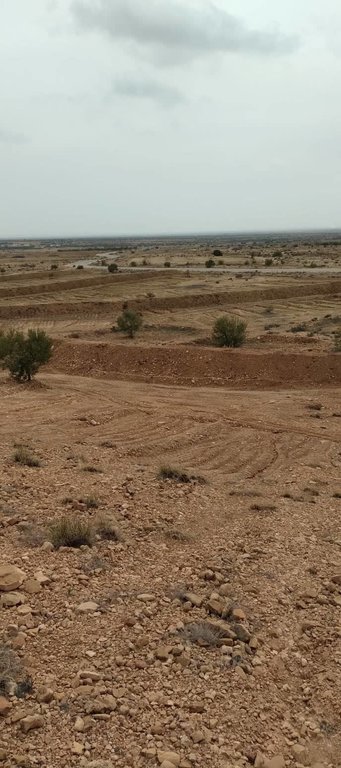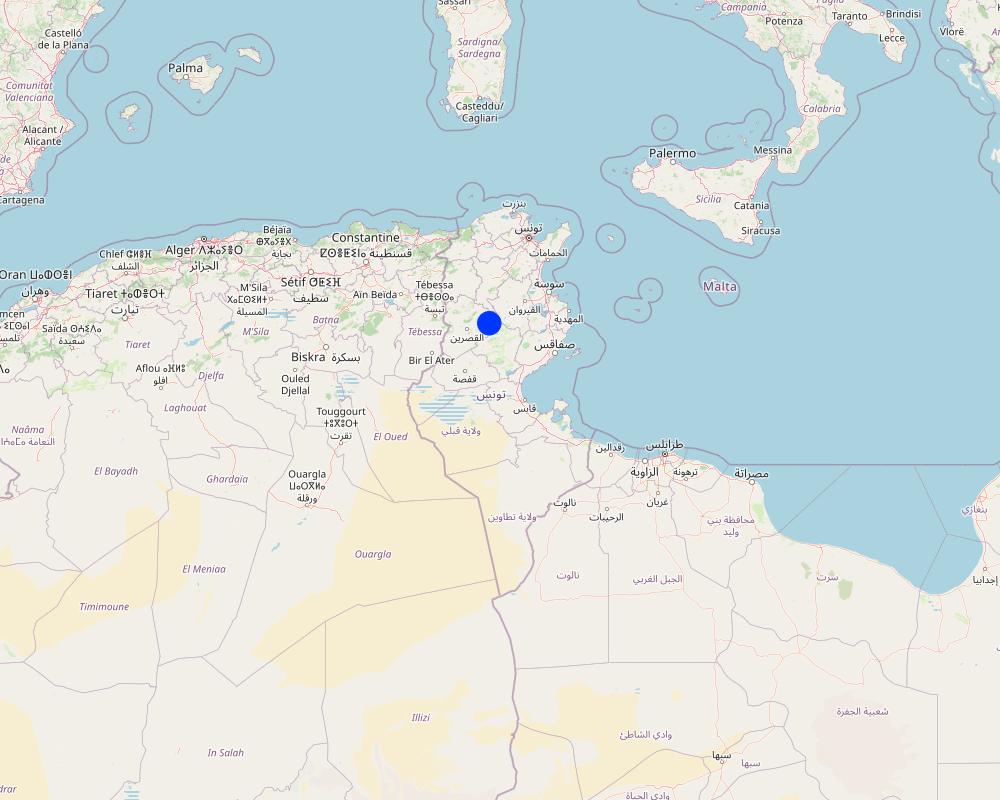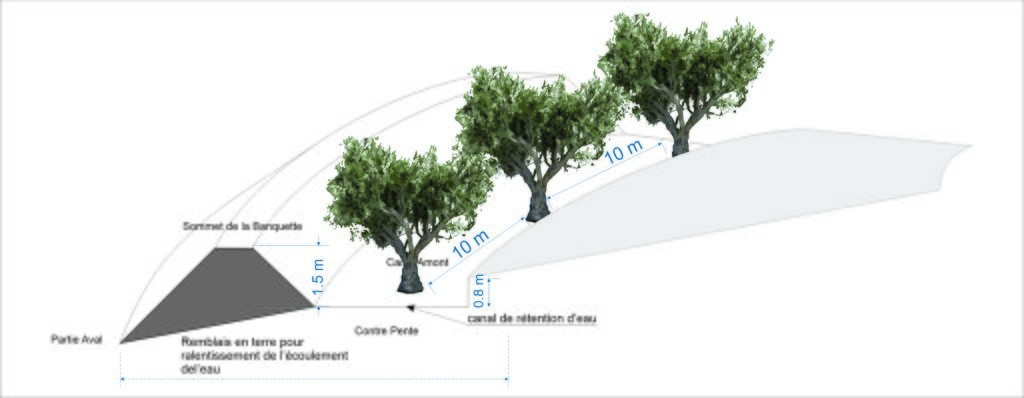Biological consolidation of mechanical benches with olive trees [Tunisia]
- Creation:
- Update:
- Compiler: Wafa Saidi
- Editors: Siagbé Golli, Faouzi Harrouchi, faouzi BATTI, Fatma Maaloul, Tabitha Nekesa, Ahmadou Gaye
- Reviewers: William Critchley, Rima Mekdaschi Studer
technologies_6674 - Tunisia
View sections
Expand all Collapse all1. General information
1.2 Contact details of resource persons and institutions involved in the assessment and documentation of the Technology
Key resource person(s)
SLM specialist:
Mnissi Adel
Directorate-General for the Development and Conservation of Agricultural Lands (DGACTA)
Tunisia
Name of project which facilitated the documentation/ evaluation of the Technology (if relevant)
Soil protection and rehabilitation for food security (ProSo(i)l)Name of the institution(s) which facilitated the documentation/ evaluation of the Technology (if relevant)
Direction Générale de l’Amenagement et de Conservation des Terres Agricoles (DG/ACTA) - TunisiaName of the institution(s) which facilitated the documentation/ evaluation of the Technology (if relevant)
GIZ Tunisia (GIZ Tunisia) - Tunisia1.3 Conditions regarding the use of data documented through WOCAT
The compiler and key resource person(s) accept the conditions regarding the use of data documented through WOCAT:
Yes
1.4 Declaration on sustainability of the described Technology
Is the Technology described here problematic with regard to land degradation, so that it cannot be declared a sustainable land management technology?
No
1.5 Reference to Questionnaire(s) on SLM Approaches (documented using WOCAT)
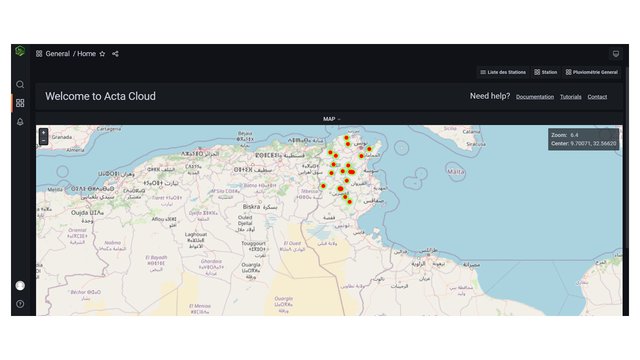
Territorial Natural Resource Management Observatory [Tunisia]
A territorial natural resources management observatory is a scientific, technical and institutional system set up in a given area to observe, monitor and improve knowledge.
- Compiler: Wafa Saidi
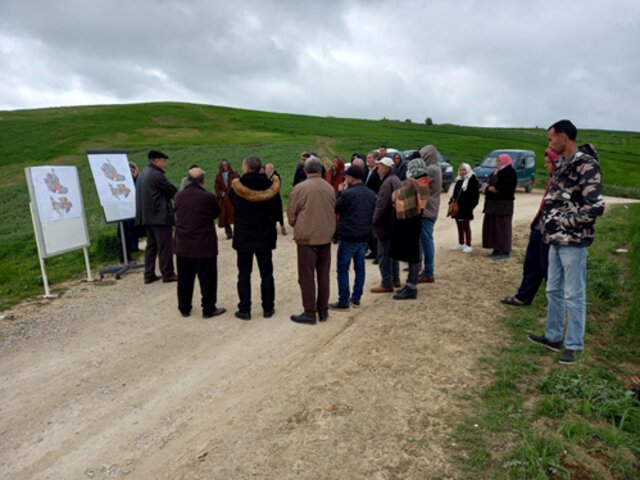
Integrated Territorial Planning and Development Project (PADIT) [Tunisia]
The PADIT approach comprises a cross-cutting participatory methodology to rural development, rallying various stakeholders around a project, within a location, to identify the main economic areas of the rural community concerned, and draw up a prioritized list of actions to strengthen and support development efforts in their location.
- Compiler: Wafa Saidi
2. Description of the SLM Technology
2.1 Short description of the Technology
Definition of the Technology:
The biological consolidation of embankments is an agricultural practice that entails planting embankments with arboricultural, pastoral, or forage species. This cultivation technique enhances the effectiveness and longevity of these structures.
2.2 Detailed description of the Technology
Description:
Anti-erosion banks are widespread in central Tunisia. In semi-arid environments, these structures consist of earthen levees built perpendicular to the slope of the land accompanied by a channel designed to retain runoff water and sediment between the banks.
Implementing and maintaining these structures can be financially burdensome for farmers, necessitating biological consolidation to ensure their long-term viability. Consolidation can be achieved using various types of tree, pasture and fodder plantations. Successful biological consolidation is contingent on factors such as soil type (nature, relief), climate (particularly annual rainfall), irrigation water resources and the species chosen. Most farmers use olive trees to consolidate soil and water conservation structures in their plots.
Consolidation efforts encompass both recent and aging structures, focusing on rehabilitation and ongoing maintenance. Planting occurs on the embankments and within their channels, providing essential plant cover and root systems that bind soil particles, reducing the risk of erosion. This technique has proven to enhance soil fertility, boost crop yields, and generate income for farmers through the sale of olives and olive oil. Despite the 10-15% loss of land surface associated with embankment installation, the consolidation process increases the overall value of the land. The presence of olive trees enhances the land's worth.
2.3 Photos of the Technology
2.5 Country/ region/ locations where the Technology has been applied and which are covered by this assessment
Country:
Tunisia
Region/ State/ Province:
Sidi Bouzid
Specify the spread of the Technology:
- evenly spread over an area
If precise area is not known, indicate approximate area covered:
- 1,000-10,000 km2
Is/are the technology site(s) located in a permanently protected area?
No
Map
×2.6 Date of implementation
Indicate year of implementation:
1998
2.7 Introduction of the Technology
Specify how the Technology was introduced:
- as part of a traditional system (> 50 years)
- through projects/ external interventions
Comments (type of project, etc.):
National Soil and Water Conservation Strategy
3. Classification of the SLM Technology
3.1 Main purpose(s) of the Technology
- improve production
- reduce, prevent, restore land degradation
- protect a watershed/ downstream areas – in combination with other Technologies
- create beneficial economic impact
3.2 Current land use type(s) where the Technology is applied
Land use mixed within the same land unit:
Yes
Specify mixed land use (crops/ grazing/ trees):
- Agro-pastoralism (incl. integrated crop-livestock)

Cropland
- Tree and shrub cropping
Tree and shrub cropping - Specify crops:
- olive
Number of growing seasons per year:
- 1
Is intercropping practiced?
No
Is crop rotation practiced?
No

Grazing land
Extensive grazing:
- Ranching
Animal type:
- sheep
Is integrated crop-livestock management practiced?
No
Species:
sheep
Count:
50

Settlements, infrastructure
- Settlements, buildings
- Energy: pipelines, power lines
3.3 Has land use changed due to the implementation of the Technology?
Has land use changed due to the implementation of the Technology?
- Yes (Please fill out the questions below with regard to the land use before implementation of the Technology)
Land use mixed within the same land unit:
No

Unproductive land
Specify:
Degraded plot
Comments:
The installation of mechanical embankments has encouraged farmers to exploit their lands and plant them with olive trees.
3.4 Water supply
Water supply for the land on which the Technology is applied:
- mixed rainfed-irrigated
3.5 SLM group to which the Technology belongs
- improved ground/ vegetation cover
- integrated soil fertility management
- cross-slope measure
3.6 SLM measures comprising the Technology

vegetative measures
- V1: Tree and shrub cover

structural measures
- S1: Terraces
3.7 Main types of land degradation addressed by the Technology

soil erosion by water
- Wt: loss of topsoil/ surface erosion

chemical soil deterioration
- Cn: fertility decline and reduced organic matter content (not caused by erosion)

biological degradation
- Bc: reduction of vegetation cover
- Bh: loss of habitats
3.8 Prevention, reduction, or restoration of land degradation
Specify the goal of the Technology with regard to land degradation:
- reduce land degradation
- restore/ rehabilitate severely degraded land
4. Technical specifications, implementation activities, inputs, and costs
4.1 Technical drawing of the Technology
Technical specifications (related to technical drawing):
- Slope < 20%.
- Distance between olive trees: 10 m
4.2 General information regarding the calculation of inputs and costs
Specify how costs and inputs were calculated:
- per Technology area
Indicate size and area unit:
1 ha
other/ national currency (specify):
Tunisian dinars
If relevant, indicate exchange rate from USD to local currency (e.g. 1 USD = 79.9 Brazilian Real): 1 USD =:
3.1
4.3 Establishment activities
| Activity | Timing (season) | |
|---|---|---|
| 1. | Purchase olive seedlings | |
| 2. | Preparing holes | |
| 3. | Planting |
4.4 Costs and inputs needed for establishment
If you are unable to break down the costs in the table above, give an estimation of the total costs of establishing the Technology:
600.0
If land user bore less than 100% of costs, indicate who covered the remaining costs:
Directorate-General for the Development and Conservation of Agricultural Lands
4.5 Maintenance/ recurrent activities
| Activity | Timing/ frequency | |
|---|---|---|
| 1. | Weed clearance | |
| 2. | Prunning | |
| 3. | Irrigation |
4.6 Costs and inputs needed for maintenance/ recurrent activities (per year)
If you are unable to break down the costs in the table above, give an estimation of the total costs of maintaining the Technology:
1000.0
4.7 Most important factors affecting the costs
Describe the most determinate factors affecting the costs:
- Availability of workers
5. Natural and human environment
5.1 Climate
Annual rainfall
- < 250 mm
- 251-500 mm
- 501-750 mm
- 751-1,000 mm
- 1,001-1,500 mm
- 1,501-2,000 mm
- 2,001-3,000 mm
- 3,001-4,000 mm
- > 4,000 mm
Specify average annual rainfall (if known), in mm:
229.00
Specifications/ comments on rainfall:
- Random and irregular annual rainfall
- Autumn and spring are the seasons with the highest levels of rainfall
Indicate the name of the reference meteorological station considered:
Sidi Bouzid (INM)
Agro-climatic zone
- arid
The average temperature is 18°C.
5.2 Topography
Slopes on average:
- flat (0-2%)
- gentle (3-5%)
- moderate (6-10%)
- rolling (11-15%)
- hilly (16-30%)
- steep (31-60%)
- very steep (>60%)
Landforms:
- plateau/plains
- ridges
- mountain slopes
- hill slopes
- footslopes
- valley floors
Altitudinal zone:
- 0-100 m a.s.l.
- 101-500 m a.s.l.
- 501-1,000 m a.s.l.
- 1,001-1,500 m a.s.l.
- 1,501-2,000 m a.s.l.
- 2,001-2,500 m a.s.l.
- 2,501-3,000 m a.s.l.
- 3,001-4,000 m a.s.l.
- > 4,000 m a.s.l.
Indicate if the Technology is specifically applied in:
- not relevant
5.3 Soils
Soil depth on average:
- very shallow (0-20 cm)
- shallow (21-50 cm)
- moderately deep (51-80 cm)
- deep (81-120 cm)
- very deep (> 120 cm)
Soil texture (topsoil):
- coarse/ light (sandy)
- medium (loamy, silty)
Soil texture (> 20 cm below surface):
- coarse/ light (sandy)
- medium (loamy, silty)
Topsoil organic matter:
- low (<1%)
If available, attach full soil description or specify the available information, e.g. soil type, soil PH/ acidity, Cation Exchange Capacity, nitrogen, salinity etc.
Organic carbon in topsoil (wt.%): 1
Topsoil pH (H2O): 8
Topsoil calcium carbonate (wt.%): 43.4
Subsoil organic carbon (wt.%): 0.35
Subsoil pH (H2O): 8.3
Subsoil calcium carbonate (wt.%): 62.7
5.4 Water availability and quality
Ground water table:
> 50 m
Availability of surface water:
poor/ none
Water quality (untreated):
for agricultural use only (irrigation)
Water quality refers to:
both ground and surface water
Is water salinity a problem?
Yes
Is flooding of the area occurring?
No
5.5 Biodiversity
Species diversity:
- low
Habitat diversity:
- low
5.6 Characteristics of land users applying the Technology
Sedentary or nomadic:
- Sedentary
Market orientation of production system:
- mixed (subsistence/ commercial)
Off-farm income:
- less than 10% of all income
Relative level of wealth:
- average
Individuals or groups:
- individual/ household
Level of mechanization:
- mechanized/ motorized
Gender:
- women
- men
Age of land users:
- youth
- middle-aged
- elderly
5.7 Average area of land used by land users applying the Technology
- < 0.5 ha
- 0.5-1 ha
- 1-2 ha
- 2-5 ha
- 5-15 ha
- 15-50 ha
- 50-100 ha
- 100-500 ha
- 500-1,000 ha
- 1,000-10,000 ha
- > 10,000 ha
Is this considered small-, medium- or large-scale (referring to local context)?
- medium-scale
5.8 Land ownership, land use rights, and water use rights
Land ownership:
- individual, not titled
Land use rights:
- individual
Water use rights:
- individual
Are land use rights based on a traditional legal system?
Yes
Specify:
Heritage
5.9 Access to services and infrastructure
health:
- poor
- moderate
- good
education:
- poor
- moderate
- good
technical assistance:
- poor
- moderate
- good
employment (e.g. off-farm):
- poor
- moderate
- good
markets:
- poor
- moderate
- good
energy:
- poor
- moderate
- good
roads and transport:
- poor
- moderate
- good
drinking water and sanitation:
- poor
- moderate
- good
financial services:
- poor
- moderate
- good
6. Impacts and concluding statements
6.1 On-site impacts the Technology has shown
Socio-economic impacts
Production
crop production
Comments/ specify:
The land was unproductive before the embankments were created.
crop quality
risk of production failure
Comments/ specify:
Embankments optimize growth conditions, reducing the risk of production failure.
Income and costs
farm income
Quantity before SLM:
0%
Quantity after SLM:
100%
Socio-cultural impacts
food security/ self-sufficiency
Ecological impacts
Soil
soil moisture
soil cover
soil loss
Climate and disaster risk reduction
flood impacts
Comments/ specify:
Embankments serve as barriers, slowing down water flow and reducing the risk of soil erosion through runoff. On the other hand, the olive tree's extensive root system can penetrate deep into the soil, preventing soil erosion and improving long-term stability.
emission of carbon and greenhouse gases
Comments/ specify:
Olive trees, like other perennial woody plants, have the capacity to sequester carbon dioxide from the atmosphere. This can help mitigate climate change by reducing greenhouse gas emissions.
6.2 Off-site impacts the Technology has shown
downstream siltation
6.3 Exposure and sensitivity of the Technology to gradual climate change and climate-related extremes/ disasters (as perceived by land users)
Gradual climate change
Gradual climate change
| Season | increase or decrease | How does the Technology cope with it? | |
|---|---|---|---|
| seasonal rainfall | wet/ rainy season | decrease | very well |
6.4 Cost-benefit analysis
How do the benefits compare with the establishment costs (from land users’ perspective)?
Short-term returns:
very positive
Long-term returns:
very positive
How do the benefits compare with the maintenance/ recurrent costs (from land users' perspective)?
Short-term returns:
very positive
Long-term returns:
very positive
6.5 Adoption of the Technology
- 11-50%
Of all those who have adopted the Technology, how many did so spontaneously, i.e. without receiving any material incentives/ payments?
- 0-10%
6.6 Adaptation
Has the Technology been modified recently to adapt to changing conditions?
No
6.7 Strengths/ advantages/ opportunities of the Technology
| Strengths/ advantages/ opportunities in the land user’s view |
|---|
| Profitability: Planting olive trees is a profitable activity for land users and involves relatively low expense. |
| Preservation of cultural heritage: Planting olive trees is of cultural importance in Tunisia. Embracing this method of cultivation allows land users to safeguard cultural heritage and uphold traditional agricultural practices. |
| Sustainability: ensures the longevity of the embankments |
| Strengths/ advantages/ opportunities in the compiler’s or other key resource person’s view |
|---|
| Olive trees are carbon sinks that help offset greenhouse gas emissions. |
| Reinforce and extend the service life of embankments. |
| Olive trees provide opportunities to develop value-added products such as olive oil, table olives and olive-based cosmetics. |
6.8 Weaknesses/ disadvantages/ risks of the Technology and ways of overcoming them
| Weaknesses/ disadvantages/ risks in the land user’s view | How can they be overcome? |
|---|---|
| Olive trees are suited to specific climatic conditions and can be sensitive to various environmental hazards, such as extreme temperatures, drought, frost or pests and diseases. | Land users must select appropriate olive varieties that are well suited to their local climatic conditions. |
| Weaknesses/ disadvantages/ risks in the compiler’s or other key resource person’s view | How can they be overcome? |
|---|---|
| Successful implementation of the technology hinges on suitable environmental conditions, including appropriate soil types, climatic factors and access to water resources. | Feasibility studies to determine the suitability of the land for olive tree planting |
7. References and links
7.1 Methods/ sources of information
- field visits, field surveys
A field survey was conducted.
- interviews with land users
A farmer was interviewed.
- interviews with SLM specialists/ experts
- compilation from reports and other existing documentation
When were the data compiled (in the field)?
01/02/2023
7.2 References to available publications
Title, author, year, ISBN:
Guide de conservation des eaux et du Sol, Ministère de l’agriculture, Direction Générale de l'Aménagement et de la Conservations des Terres Agricoles, 1995: Ministère de l’agriculture, Direction Générale de l'Aménagement et de la Conservations des Terres Agricoles
Available from where? Costs?
Ministry of Agriculture, Directorate-General for the Development and Conservation of Agricultural Lands
Title, author, year, ISBN:
Carte agricole de la Tunisie, Ministère de l’agriculture, 2005
Available from where? Costs?
Ministry of Agriculture, Directorate-General for the Development and Conservation of Agricultural Lands
Title, author, year, ISBN:
Analyse du système des banquettes mécaniques Propositions d'améliorations, de valorisation et d'évolution pour les gouvernorats de Kairouan, Siliana et Zaghouan, Tunisie, Eric Roose, 2002
Available from where? Costs?
Ministry of Agriculture, Directorate-General for the Development and Conservation of Agricultural Lands
7.3 Links to relevant online information
Title/ description:
Harmonized World Soil Database (HWSD), FAO, 2008
URL:
https://www.fao.org/soils-portal/data-hub/soil-maps-and-databases/harmonized-world-soil-database-v12/en/
Links and modules
Expand all Collapse allLinks

Territorial Natural Resource Management Observatory [Tunisia]
A territorial natural resources management observatory is a scientific, technical and institutional system set up in a given area to observe, monitor and improve knowledge.
- Compiler: Wafa Saidi

Integrated Territorial Planning and Development Project (PADIT) [Tunisia]
The PADIT approach comprises a cross-cutting participatory methodology to rural development, rallying various stakeholders around a project, within a location, to identify the main economic areas of the rural community concerned, and draw up a prioritized list of actions to strengthen and support development efforts in their location.
- Compiler: Wafa Saidi
Modules
No modules


